Just How Bad is Denominational Decline?
A deep dive into the trajectory of nine denominations.
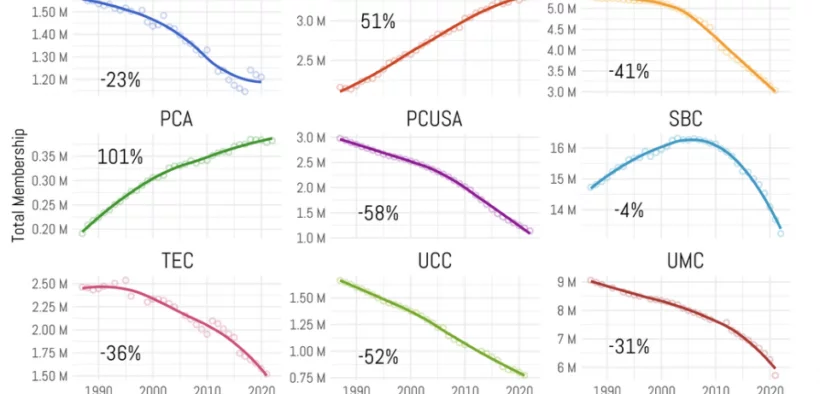
(ANALYSIS) One mistake that I make all the time is assuming that someone else has probably done the work that needs to be done to get the answer that I want. This post was driven by looking for an answer to a pretty simple question: If denominations just managed to grow at the same rate as the general population of the United States, how large would they be today?
I mean, it’s readily apparent that denominations are losing membership at an alarming rate. I wrote a deep dive into the Presbyterian Church (U.S.A.) a few weeks ago. But I wanted to be a little less deep and a little broader in this post.
I grabbed membership data on nine denominations. There are six in the mainline tradition: American Baptist Church, Evangelical Lutheran Church of America, Presbyterian Church (U.S.A.), the Episcopal Church, the United Church of Christ and the United Methodist Church. Those six represent the vast majority of the mainline.
There are three in the evangelical tradition included as well: the Assemblies of God, the Southern Baptist Convention and the Presbyterian Church of America. The SBC is easily the largest denomination in the evangelical family, and the AoG is growing quickly. The PCA was added for two reasons: People ask me about it all the time, and the PCA folks make their data easy to find.
That’s really the first question I ask when someone wants some information about their denomination: do they make their data easy to acquire in a decent format? If they don’t, I just don’t bother with it. The biggest blind spot here is nondenominational Protestant Christianity. There is absolutely no way to gather data on that tradition, but it’s clear that it’s growing incredibly fast.
But the focus here is on denominational Protestantism. So, keep that in mind. 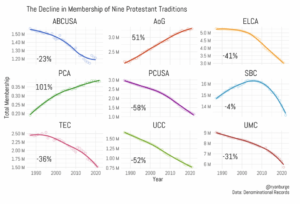
This is the percentage change in membership between 1987 and 2021. That first date is completely arbitrary, but I think it actually may represent the high-water mark for denominational membership for a few reasons that I outline here.
The mainline is just a bloodbath. Five traditions are down by at least 30%. The ELCA is down 41%. The United Church of Christ is less than half the size it was in the late 1980s. The United Methodists are already down 31%, but with over 15% of their churches disaffiliating just this year, I wouldn’t be surprised in membership is down 40% or more by this time next year.
The SBC is only down 4%, but that’s just because its decline has been way more recent. I go into a lot of detail about that here.
Access to MinistryWatch content is free. However, we hope you will support our work with your prayers and financial gifts. To make a donation, click here.
There are two traditions that are up. The Assemblies of God has grown by over 50% in the 35 years. The PCA has doubled in size, as well. But it’s important to put that PCA number in perspective. Even today, there are only about 400,000 members. For every PCA in the United States, there are about 33 Southern Baptists.
One thing I like to do is look at year over year change in membership. That can give us a better sense if the growth rate of a denomination is slowing down or if the rate of decline is speeding up. 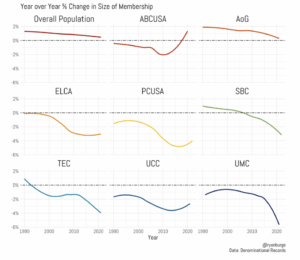
Notice that the trend line here is clearly down. (For the record, the ABC numbers cannot be right, and I’m saying that as a 20-year minister in the denomination). For instance, note that lots of denominations are seeing 3-4% year over year declines in membership. That is obviously very, very bad. For many, the percentage drops have only accelerated in the last five years.
I wanted to point out that the Assemblies of God numbers are not doing as well as the first graph would indicate. Sure, they have grown 50% since the late 1980s. But notice the last few years? Their growth rate has declined from 2% per annum to nearly 0% in the last few years. If that continues, the AoG might start shedding members as well.
So, here’s really what I wanted to do with this post: find out what the trajectory of denominations would look like if I took their membership in 1990 and just projected their growth mirroring the overall population growth of the United States. That helps us answer questions like: How big would the SBC (or UMC) be if it just kept up with natural population growth? 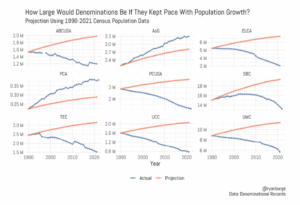
The results are pretty stark, honestly. One thing that stuck out to me is how these denominations were falling behind even in the 1990s. It’s not like they were still mirroring for the population for a decade and then began to fall off — just the opposite. For many, they were already losing market share in the early 1990s.
I think some of these trend lines are really interesting, though. For instance, the UCC was already way off the pace by 1995, and the gulf between the projection and the actual numbers just kept widening. For the ELCA it was a pretty small gap until about 2008; then it accelerated rapidly. That also happened for the SBC. Even into 2010, the difference between the lines is not huge, but the last decade or so has been catastrophic.
Obviously the two outliers are the AoG and the PCA. They are growing faster than the natural increase in the population. The AoG growth is clearly less dramatic than the PCA, though.
How large would these denominations be if they just kept growing with the population compared to how many members they actually report? 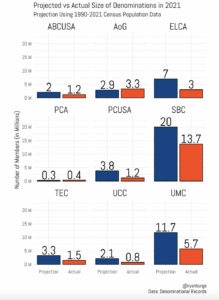
If these nine denominations would have grown as fast as the population from 1990 through 2022, they would have about 53 million members today. That’s about 16% of the overall population of the country.
Instead, they have a membership of 30.8 million people. That’s a total gap of just over 21 million members that don’t exist today. Those 30.8 million folks are just 9.3% of the total population. So, just these nine denominations are slightly more than half the size they should be if they continued to grow with America.
Obviously, this doesn’t represent all of American religion or even all of Protestant Christianity. But it is certainly indicative of the shifting religious landscape. Denominations are in decline — almost all of them, honestly.
I tried to point toward two here that are growing, but PCA is still incredibly small. The Southern Baptist Convention lost more members last year than the entire membership of the PCA. So, it cannot, in any meaningful way, fill the gap. And the Assemblies of God is growing, but at much lower rates in recent years.
Denominational Christianity used to be an incredibly important cultural force in American life. Leaders in these traditions used to hold sway over millions. Today, they are a shell of their former selves.
There’s this old saying in sports — winning fixes everything. If your team has a ton of problems but still manages to win more than it loses, those issues are easy to paper over. But when the losses pile up, that’s when things get ugly.
And, yes, I am very much thinking about what’s happening with the two largest denominations in America right now.
The Southern Baptists are going through a bitter dispute that hearkens back to the fights in the mid-1980s. The SBC emerged from those conflicts by continuing to enjoy membership growth. It seems unlikely that will be the case this time.
Meanwhile, the United Methodist Church will be drastically smaller next year than it was just two years ago in what can only be described as the largest denominational schism in the last 50 years.
These fights will not end in the near future. They will only accelerate. The big winner? That new nondenominational church down the road that has no institutional baggage.
This article was originally published at Ryan Burge’s “Graphs about Religion” column on Substack.



